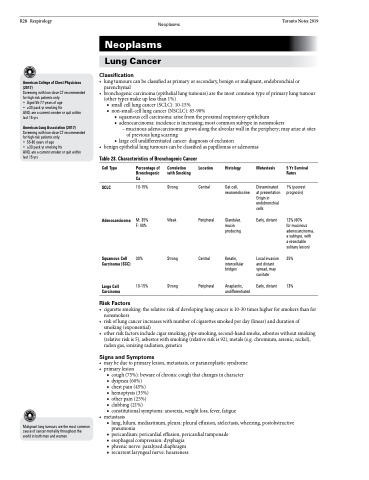Page 1274 - TNFlipTest
P. 1274
R28 Respirology
American College of Chest Physicians (2017)
Screening with low-dose CT recommended for high-risk patients only:
• Aged 55-77 years of age
• ≥30 pack yr smoking Hx
AND, are a current smoker or quit within last 15 yrs
American Lung Association (2017)
Screening with low-dose CT recommended for high-risk patients only:
• 55-80 years of age
• ≥30 pack yr smoking Hx
AND, are a current smoker or quit within last 15 yrs
Neoplasms Toronto Notes 2019 Neoplasms
Lung Cancer
Classification
• lungtumourscanbeclassifiedasprimaryorsecondary,benignormalignant,endobronchialor parenchymal
• bronchogenic carcinoma (epithelial lung tumours) are the most common type of primary lung tumour (other types make up less than 1%)
■ small cell lung cancer (SCLC): 10-15%
■ non-small-cell lung cancer (NSCLC): 85-90%
◆ squamous cell carcinoma: arise from the proximal respiratory epithelium
◆ adenocarcinoma: incidence is increasing; most common subtype in nonsmokers
– mucinous adenocarcinoma: grows along the alveolar wall in the periphery; may arise at sites of previous lung scarring
◆ large cell undifferentiated cancer: diagnosis of exclusion
• benign epithelial lung tumours can be classified as papillomas or adenomas
Table 28. Characteristics of Bronchogenic Cancer
Cell Type
SCLC
Adenocarcinoma
Squamous Cell Carcinoma (SCC)
Large Cell Carcinoma
Risk Factors
Percentage of Bronchogenic Ca
10-15%
M: 35% F: 40%
30%
10-15%
Correlation with Smoking
Strong
Weak
Strong
Strong
Location
Central
Peripheral
Central
Peripheral
Histology
Oat cell, neuroendocrine
Glandular, mucin producing
Keratin, intercellular bridges
Anaplastic, undifferentiated
Metastasis
Disseminated at presentation Origin in endobronchial cells
Early, distant
Local invasion and distant spread, may cavitate
Early, distant
5 Yr Survival Rates
1% (poorest prognosis)
12% (60%
for mucinous adenocarcinoma, a subtype, with a resectable solitary lesion)
25%
13%
Malignant lung tumours are the most common cause of cancer mortality throughout the world in both men and women
• cigarettesmoking:therelativeriskofdevelopinglungcanceris10-30timeshigherforsmokersthanfor nonsmokers
• riskoflungcancerincreaseswithnumberofcigarettessmokedperday(linear)anddurationof smoking (exponential)
• otherriskfactorsincludecigarsmoking,pipesmoking,second-handsmoke,asbestoswithoutsmoking (relative risk is 5), asbestos with smoking (relative risk is 92), metals (e.g. chromium, arsenic, nickel), radon gas, ionizing radiation, genetics
Signs and Symptoms
• maybeduetoprimarylesion,metastasis,orparaneoplasticsyndrome • primarylesion
■ cough (75%): beware of chronic cough that changes in character ■ dyspnea (60%)
■ chest pain (45%)
■ hemoptysis (35%)
■ other pain (25%)
■ clubbing (21%)
■ constitutional symptoms: anorexia, weight loss, fever, fatigue
• metastasis
■ lung, hilum, mediastinum, pleura: pleural effusion, atelectasis, wheezing, postobstructive
pneumonia
■ pericardium: pericardial effusion, pericardial tamponade
■ esophageal compression: dysphagia
■ phrenic nerve: paralyzed diaphragm
■ recurrent laryngeal nerve: hoarseness


